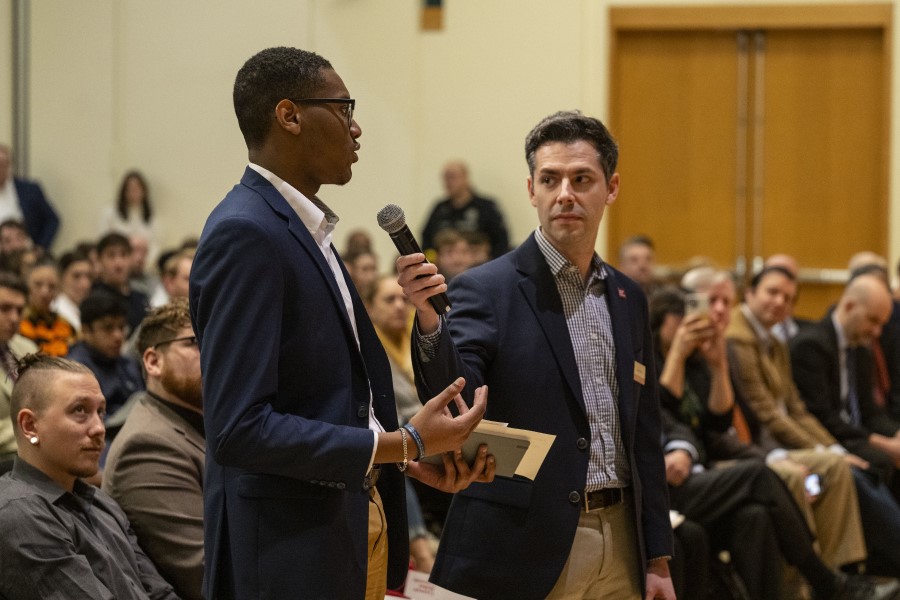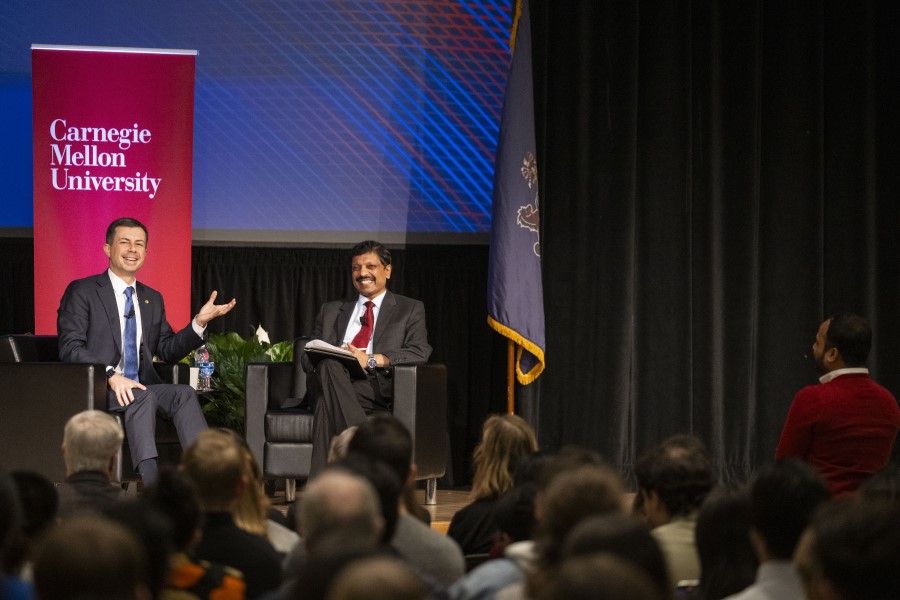Secretary of Transportation Pete Buttigieg Emphasizes Safety During CMU Visit
By Michael Henninger
During a visit to Carnegie Mellon University, U.S. Secretary of Transportation Pete Buttigieg answered questions from Carnegie Mellon students about safety and equity, artificial intelligence, aviation and his time leading the Department of Transportation (DOT).
In Pittsburgh to announce more than $142 million slated for repairs and improvements to I-376, Buttigieg said that once he knew he was coming to the area he wanted to come to Carnegie Mellon.
"I think this is a place that really gets the relationship between cool, interesting ideas and technologies, and the why of it all," Buttigieg said. "The reason why transportation technologies — any technologies — matter, isn't that they're cool. Although, most of us, I think, are nerds who just think they're intrinsically cool. But it's the why of it, how they make us safer and how they help us address issues like equity and climate."
The previous two DOT secretaries have also visited CMU: Anthony Foxx and Elaine Chao.
"Carnegie Mellon University continues to shape the national innovation and policy agenda, and — as the secretary's visit to campus today indicates — we remain a destination for White House officials and thought leaders seeking our engagement and expertise," said CMU President Farnam Jahanian. "We are delighted to have hosted Secretary Buttigieg this morning and thrilled that CMU researchers, including our amazing students, are playing a leading role in responding to our nation's challenges and opportunities in transportation, mobility, infrastructure and beyond."

Jordan Thompson asks about emerging transportation technologies during the Q&A. Watch the full Q&A here.
In 2023, Congresswoman Summer Lee announced that CMU would lead Safety21, a national University Transportation Center where partners from across the country collaborate to ensure that autonomous, networked, shared and integrated transportation technologies and systems are developed and deployed with safety, equity and sustainability in mind. The center also focuses on providing training for the existing and emerging transportation workforce. Safety21 is the fourth national University Transportation Center that Carnegie Mellon has managed since 2012. Over five years, Safety21 will receive $20 million in funding from DOT.
"Safety21 is another example of the important work that we are doing at the nexus of technology and society," said Ramayya Krishnan, dean of the Heinz College of Information Systems and Public Policy, during his introductory remarks. "Each Safety21 project involves collaborations with deployment and equity partners from state and local government as well as the not-for-profit sector. The resulting research and the other outcomes from these collaborations help the U.S. DOT achieve its strategic goals of promoting safety and innovation."
CMU's Raj Rajkumar, George Westinghouse Professor in the Department of Electrical and Computer Engineering, moderated a Q&A in which Buttigieg thoughtfully responded to student questions about, among other topics, safety in aviation regulation, economic opportunities of commercial space travel and the future of AI in transportation.
Lindsay Graff, a Ph.D. student studying civil engineering at CMU who previously worked for Delta Airlines, asked Buttigieg about steps being taken by the Federal Aviation Administration to maintain proper safety regulations despite lobbying pressure.
"Safety is not some kind of destination," Buttigieg said. "We've had a number of incidents — the Alaska plug door is just one of them — that demonstrate that you can't just say, 'OK, we've figured out how to make planes safe. Now they're safe.' But rather that you have to continually evolve. And that's not just true in terms of technology. That's true in terms of regulation."
Jordan Thompson, economic development and policy intern at the Regional Industrial Development Corporation of Southwestern Pennsylvania (RIDC), asked the secretary which emerging transportation technologies have the greatest potential for widespread deployment to improve mobility for communities.

Buttigieg answers a question from Shubham Goel.
"Anything that enhances the safety of our roadways has our kind-of top tier of attention," Buttigieg replied. "We were talking about aviation safety.
"A near-miss leads to national news, and a lot of work for our department. Meanwhile, the number of people who will get killed today on our road- ways is about the same as the number of people who can fit on a 737. And the same thing happened yesterday. And the same thing's going to happen tomorrow. Which means even a 1% reduction in the number of roadway fatalities in this country, that's 400 people. The question is, 'How can these kinds of technologies help?"'
Shubham Goel, a research assistant for Safety21, asked how DOT was integrating AI technologies to enhance transportation systems in the United States and how student organizations could become involved.
"We have to start thinking of AI, even in these early days, as a competency, not just a specialty," Buttigieg said. "It's just a thing you need to know how to do to do your job. There are also some things that are more AI specific: A great example that I'm intrigued by, that has some of the research from this institution in its DNA, is applying AI to what it means to have complete streets."
Before leaving, Buttigieg shared his hope for the future, the world he envisions for his toddler-age twins and what he hopes to be able to say to them.
"We figured all this out on our watch. We're handing it to you in better shape than we found it," he said.
"I believe in that possibility. I work every day on that possibility. You all, whether it's in your civic activism, advocacy and involvement or in your research interests, are contributing to that. And that's what fills my sails."